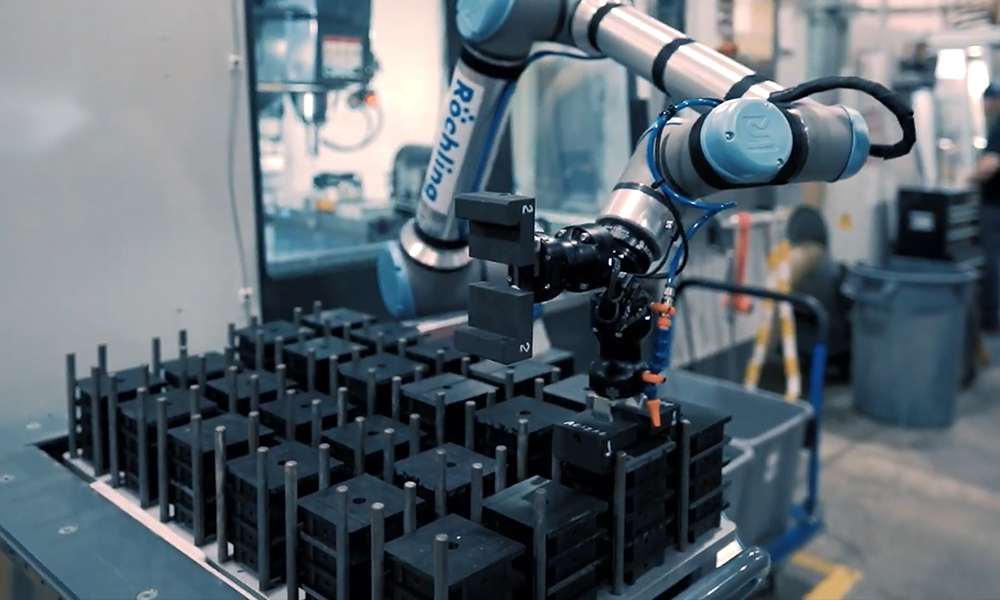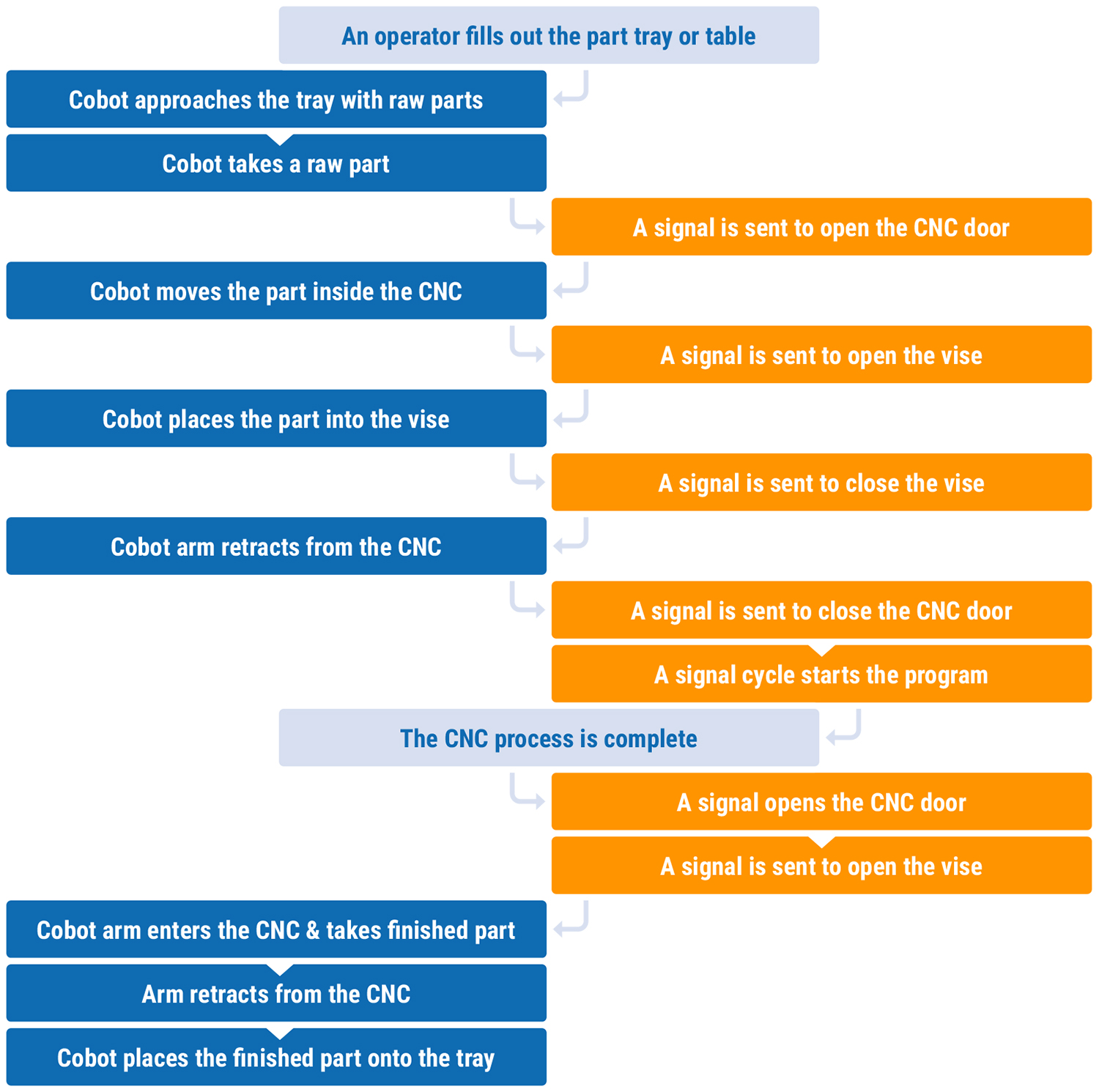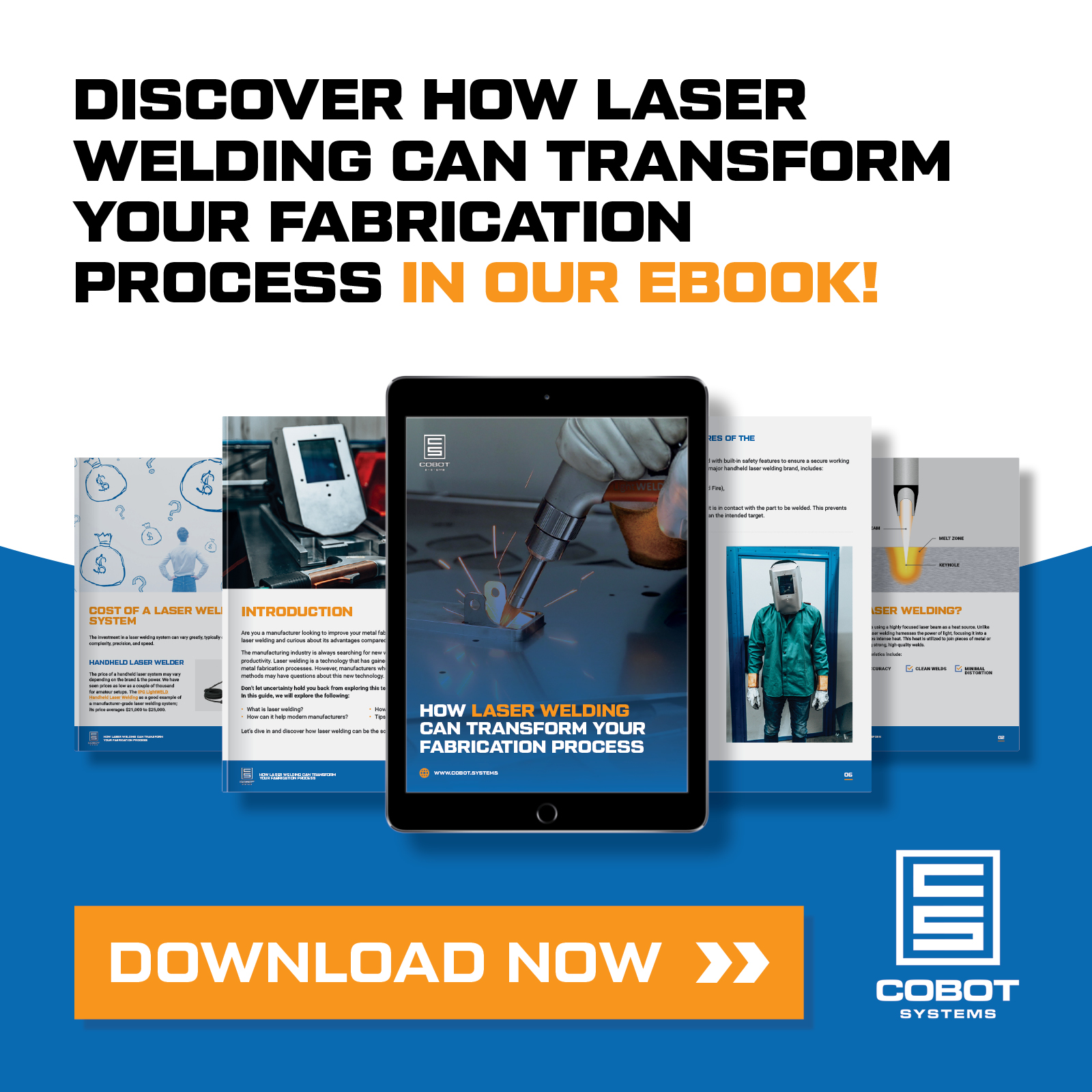Freeing your specialized staff from the burden of loading/unloading the CNC can have a remarkable impact on your production. This guide will show you how to automate CNC machine tending and how simple the process can be with the right system.
You’ll also learn some pitfalls to avoid and details that can make a world of difference.
What is Automated CNC Machine Tending?
Automated CNC machine tending automates feeding raw parts into the CNC and removing the machined product—all without a human involvement. It improves productivity, reliability, and accuracy. Most importantly, it frees up your operators for more fulfilling tasks.
Manually, CNC machine tending is a dull and repetitive job that’s prone to injury and quality issues. It’s very difficult to find people to run CNC manually. As you’ve probably experienced yourself, this position has a high turnover rate. The Deloitte Insights’ study projects the need for about 2.1 million jobs in manufacturing by 2030, out of which 38,000 are machinists and 113,200 are fabricators.

Automated CNC vs Robotic CNC Machine Tending
Automated CNC systems contain components like part feeders and pallet loaders to improve uptime and throughput with minimal human intervention. However, these types of automation aren’t always the best fit for volatile applications. For example, pallet loaders require high labor time for fixturing, especially in a high-mix environment. While they increase CNC efficency, they may reduce operator’s productivity and raise labor costs.
Robotic CNC machine tending also automates the process, but offers more flexibility. Robots can handle variable parts and be quickly adapted to any changes in production. You can program a robot for pre- or post-machining tasks and reprogram it whenever a need arises. Robots are significantly better suited for dynamic or high-mix low-volume production than CNC part-feeding automation.
How to Automate CNC Machine Tending With a Robot
If done right, robotic CNC machine tending can work wonders for your business. The points below are critical for successful robotic CNC machine tending automation.
1. Consider The Robot Type: Cobots vs. Traditional Robots
You can use traditional or collaborative robots (cobots) for CNC machine tending. However, cobots have multiple advantages for this purpose. For example, your operators can work alongside cobots in the same workspace. Cobots are also more flexible than traditional robotics, as you can program and reprogram them usually in less time.
Many cobot brands, like Universal Robots, use a simple teach pendant with graphical interface that doesn’t require coding for programming. In contrast, traditional robots usually require working with more complex software and coding.
Cobots usually don’t require safety fencing. After conducting a risk assessment, a simple area scanner will typically be sufficient for operator safety.. So, you don’t need to enclose a large area around the CNC. This is critical for reducing footprint in small shops with minimal space.
2. Decide On an Efficient Mounting Configuration
You can mount your cobot for CNC tending in four ways:
• Pedestal/floor – Fixed position that gives the cobot the reach all around it.
• Cart – A mobile platform that allows you to move the cobot to the machine it needs to tend. You must ensure that all locations of the parts to be fed or deposited after CNC shapes them are placed in the same location relative to the cobot.
• Ceiling/rail – Reduces the needed floor space and makes it easier for the operator to access the front of the machine when necessary. Mounting the cobot on a rail can extend its range and allow it to tend to multiple CNC machines.
• Machine – Mounted directly to the CNC machine. It reduces the needed space, making it easy to deploy tending in a tight space.
Mounting type can affect the whole system’s efficiency and productivity. Consider the part types, sizes, workspace size, if the operator must access the CNC, and how the cobot needs to approach the part to find the most suitable mounting for your production.
3. Evaluate the Robot Tasks And Consider The Cycle Time
A simple process of CNC machine tending with a cobot can look something like this:

That’s a starter outline you can modify or build upon. Everyone’s production parts and processes are unique. So, you may have additional steps, like the cobot placing a piece onto a re-grip station that centers it before the cobot can grip it properly.
You should also consider the cobot’s payload and reach. Some tasks are better suited for smaller cobots, others for larger ones. Likewise, evaluate the needed cycle time and whether the cobot can keep up.
Feel free to contact us. We’ll be happy to discuss your production and help you determine the robot tasks and the most efficient way to implement them.
4. Use Appropriate Tooling
Cobot end-of-arm (end-effector) tooling must match the part size and material type. For CNC tending, tooling is usually in the form of a gripper. For example, the CNC Machine Tending Cobot System uses adaptable grippers with custom fingertips to fit your parts. Likewise, the grippers can be electric or pneumatic and have two or three jaws.
Using the most suitable gripper type can significantly speed up the process. For example, a dual gripper configuration can increase uptime and reduce idle time. It can unload a finished part and load raw material in the vise simultaneously, without getting in-and-out to start the next part.
5. Use Automated Vises
Your CNC machines may have manual vises. For automated CNC machine tending, we recommend an automatic pneumatic or hydraulic vise, so your cobot can control it. For example, our CNC tending cobot can be connected to the CNC foot pedal, allowing the cobot to use the system as the operator would. This maximizes the system’s efficiency, precision, and autonomy.
The added benefit of automatic vise is significantly better clamping precision and uniformity. Manually clamping the part uses inconsistent force, while automated vises always close with the same force.
6. Consider The CNC Door System
For maximum autonomy and efficiency, your CNC doors should automatically open and close upon receiving a signal from the cobot. Some CNC tending systems use a cobot to manually open the door by griping the door handle, but this is terribly inefficient and can cause robot faults.
The CNC Machine Tending Cobot System uses noninvasive, soft integration that sends a signal to the CNC’s door to open/close automatically. However, there’s also a solution for manual doors. If your CNC doesn’t have the ability to receive door signals, we can install a dedicated door opener controlled by the cobot.
7. Handling Robot to CNC Communication
Your cobot system must be able to communicate with the CNC controls to perform actions such as vise activation, initiating the CNC process, and opening and closing the doors.
You don’t want the cobot to push the buttons with it’s arm. This reduces the system’s efficiency and leaves room for error. Some cobot integration solutions use I/O’s to control the system. Likewise, you might also see systems using PLC controlores or integrating directly into the CNC controller. However, this is more complex, depends on the CNC brand, and is more intrusive, especially for new CNC machines.
Cobot Systems supports a non-invasive integration where buttons are pushed physically using a small pneumatic actuator. So, The CNC Machine Tending Cobot System does exactly what the operator would, but it’s automated. See our Xcelicut LLC case study in the video as an example.
Integration method / Efficiency
8. Have a Part Feeding Solution Suitable For Your Parts
Your part presentation solution should allow precise and consistent part placement for the cobot to pick up for CNC milling. Placing tens of parts on a tray significantly reduces the operator input and improves the system’s uptime. Furthermore, this allows you to scale automation and have your operator “feed” and run multiple CNC systems.
You can use a bulk feeder, drawer, or a simple tray. For smaller operations, a well-optimized tray on a table works great. You can use the same tray for raw and finished parts or place milled parts on a separate tray.
There are many ways to optimize the part presentation and loading process. It’s critical to ensure your cobot places the part in the vise the same way. You can use a precise pick, a re-grip station, or have the vise center the part. The Cobot Systems’ experienced team can help you find the most efficient part-feeding method for your CNC machine tending operation.
9. Consider The Software And Support
Programming a CNC machine tending process can be challenging, depending on the software and support you get from your cobot integrator.
The Cobot Systems’ solution for CNC machine tending uses a highly intuitive teach pendant software that your operator can learn quickly. Likewise, the Cobot Systems’ experienced team can help you figure out all of the steps discussed above.
Cobot Systems has deployed 250 CNC machine tending systems in the last 5 years. The team knows the ins and outs of what makes an efficient system that works long-term. Even if you are entirely new to robotics, Cobot Systems will help you get started right and avoid pitfalls that can minimize your ROI.
“Prior to getting our cobot system, we had absolutely no experience operating and programming robots. My team member who’s currently programming and working with the robot was able to pick it up extremely quickly; in time that the Cobot System’s team was on site where they looked at our actual application and helped him work through what would be the best way to handle the parts, move the robot, and things like that. It’s been a great experience going from next to nothing to being able to run production.” – Will Fennel, Owner, Xcelicut.
Let’s Discuss Your Automation Needs
Reach out today, and we’ll be happy to help you determine whether your business can benefit from automated CNC machine tending and how to implement it.
We’ve helped businesses like Röchling Industrial and Xcelicut say farewell to the boring parts of their job. Now, robots load and unload their CNC machines, solving the labor challenge and significantly improving productivity.







